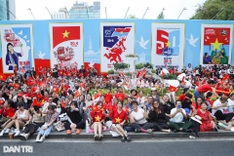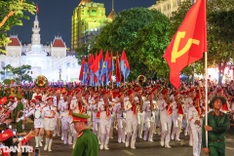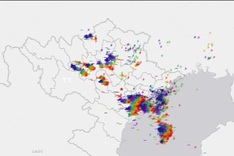Lack of demand has forced the biggest shop which sells Dong Ho paintings in the birthplace of the art form in the northern province of Quang Ninh to sell commonplace souvenirs to make ends meet.

"Dam cuoi chuot" (Rat wedding), a Dong Ho painting,
shows rats cautiously hand gifts to the cat to have peace for their wedding party
The paintings themselves do not bring in any money.
Dong Ho villagers say the national art of woodcut painting is “dying,” according to a November 4 report in Lao Dong newspaper.
Nguyen Dang Nhan runs the “Traditional folk culture center” in Dong Khe village (formerly Dong Ho and Tu Khe villages). Situated on more than five hectares, its aim was to continue producing and promoting Dong Ho paintings.
But the paintings and their materials have been doing nothing but collect dust, as no visitors have bought any for several years, Nhan said.
The center was originally opened by Nhan’s father, Nguyen Dang Che, “to keep some of the fragrance of the village’s craft.” The family has been involved in the art form for 22 generations.
Theirs is one of the three families still making Dong Ho paintings in the village; the other two are doing so on a much smaller scale.
The Bac Ninh Geography Archive suggests that Dong Ho paintings originated between 866 and 873 AD, when a Chinese regional military governor of the Tang Dynasty established Dong Ho village and taught people the art.
But several local adaptations made the Dong Ho style of painting a unique and quintessential Vietnamese art form.
Vietnamese artists invented their own paper – diep, made from the powder from the bark of do (Rhamnoneuron balansae) tree, soaked in water for months, then mixed with the powder of seashell (so diep), and glutinous rice.
The paper has been credited with giving the paintings a warm, sparkling background and that cannot be found in China.
Natural colors, which last a long time, are used. Red comes from red gravel, black from the coal of burned bamboo leaves, and yellow from hoe flowers (Styphnolobium japonicum).
Paint is applied to the woodblock and then pressed on a sheet of paper like a stamp. The process is repeated with different woodblocks for different colors and images. One color needs to air-dry before another color is pressed.
Dong Ho artists use themes close to the traditional daily lives of Vietnamese people such as roosters, pigs, folk games, festivals, weddings and protestors of corruption.
“The paintings these days maintain that content and the traditional manual stages, but they have been forgotten amid too many kinds of entertainment,” said Nguyen Huu Sam, a local artist among those committed to keeping the art form relevant.
The man in his 80s was excited talking about the heyday of Dong Ho paintings during the French colonial period.
He says every house in the village made the paintings and that business was best around Tet – the Lunar New Year festival, where the paintings filled the village’s roads with vibrant colors.
“People loved it not only because it was a rare kind of painting but because it clearly depicts the life and culture of Vietnamese people.”
When the Vietnam War ended in 1975, the art was revived and was exported, but production gradually began diminishing from the early 1990s.
Villagers are now busy making and trading votive objects, a practice which was brought to Vietnam by the Chinese governor at the same time as Dong Ho paintings.
Le Xuan Bac, a district culture official, says “people don’t make a lot of profit from the votive business, but it manages to give them a living.”
While that may be pragmatic, many are nostalgic for the old days.
Cultural researcher Nguyen Van Hau says “the last colors are fading.”
The researchers say the loss of the painting would be “regretful” as it is among few that can represent the Vietnam’s art history.
Professor To Ngoc Thanh, chairman of Vietnam Folk Culture and Arts Association, blamed the “unselective” arrivals of too many waves of foreign culture for taking up the space the paintings once occupied.
He suggested the art form be reintroduced in curricula at Vietnam's art schools.
Thanh said he and other artists have repeatedly asked the government to treat Dong Ho painting as a “special” kind of art that needs protection, but they have yet received support.




















